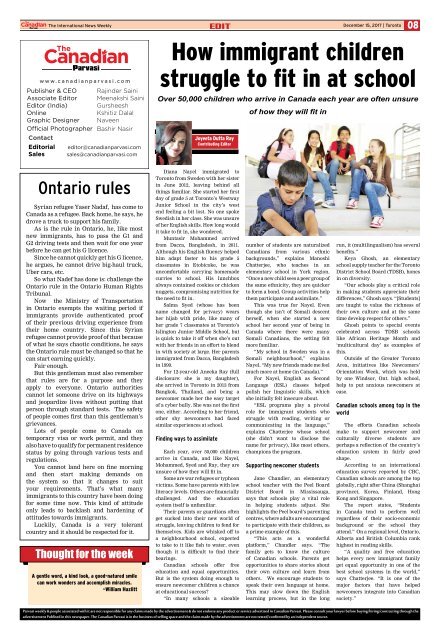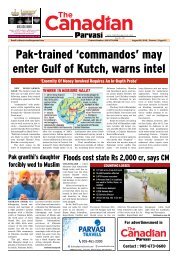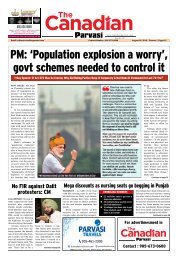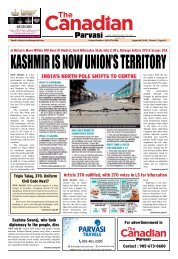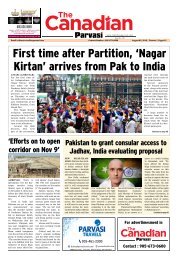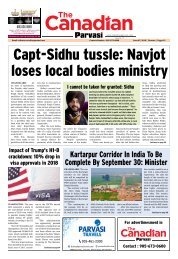Create successful ePaper yourself
Turn your PDF publications into a flip-book with our unique Google optimized e-Paper software.
<strong>The</strong> International News Weekly EDIT<br />
08<br />
December 15, 2017 | Toronto<br />
<strong>The</strong><br />
w w w . canadianparv asi. c o m<br />
Publisher & CEO<br />
Associate Editor<br />
Editor (India)<br />
Online<br />
Graphic Designer<br />
Official Photographer<br />
Contact<br />
Editorial<br />
Sales<br />
Rajinder Saini<br />
Meenakshi Saini<br />
Gursheesh<br />
Kshitiz Dalal<br />
Naveen<br />
Bashir Nasir<br />
editor@canadianparvasi.com<br />
sales@canadianparvasi.com<br />
How immigrant children<br />
struggle to fit in at school<br />
Over 50,000 children who arrive in Canada each year are often unsure<br />
Joyeeta Dutta Ray<br />
Contributing Editor<br />
of how they will fit in<br />
Ontario rules<br />
Syrian refugee Yaser Nadaf, has come to<br />
Canada as a refugee. Back home, he says, he<br />
drove a truck to support his family.<br />
As is the rule in Ontario, he, like most<br />
new immigrants, has to pass the G1 and<br />
G2 driving tests and then wait for one year<br />
before he can get his G licence.<br />
Since he cannot quickly get his G licence,<br />
he argues, he cannot drive big-haul truck,<br />
Uber cars, etc.<br />
So what Nadef has done is: challenge the<br />
Ontario rule in the Ontario Human Rights<br />
Tribunal.<br />
Now the Ministry of Transportation<br />
in Ontario exempts the waiting period if<br />
immigrants provide authenticated proof<br />
of their previous driving experience from<br />
their home country. Since this Syrian<br />
refugee cannot provide proof of that because<br />
of what he says chaotic conditions, he says<br />
the Ontario rule must be changed so that he<br />
can start earning quickly.<br />
Fair enough.<br />
But this gentleman must also remember<br />
that rules are for a purpose and they<br />
apply to everyone. Ontario authorities<br />
cannot let someone drive on its highways<br />
and jeopardize lives without putting that<br />
person through standard tests. <strong>The</strong> safety<br />
of people comes first than this gentleman’s<br />
grievances.<br />
Lots of people come to Canada on<br />
temporary visa or work permit, and they<br />
also have to qualify for permanent residence<br />
status by going through various tests and<br />
regulations.<br />
You cannot land here on fine morning<br />
and then start making demands on<br />
the system so that it changes to suit<br />
your requirements. That’s what many<br />
immigrants to this country have been doing<br />
for some time now. This kind of attitude<br />
only leads to backlash and hardening of<br />
attitudes towards immigrants.<br />
Luckily, Canada is a very tolerant<br />
country and it should be respected for it.<br />
Thought for the week<br />
A gentle word, a kind look, a good-natured smile<br />
can work wonders and accomplish miracles.<br />
~William Hazlitt<br />
Diana Nayel immigrated to<br />
Toronto from Sweden with her sister<br />
in June 2012, leaving behind all<br />
things familiar. She started her first<br />
day of grade 5 at Toronto’s Westway<br />
Junior School in the city’s west<br />
end feeling a bit lost. No one spoke<br />
Swedish in her class. She was unsure<br />
of her English skills. How long would<br />
it take to fit in, she wondered.<br />
Muntasir Mohammed arrived<br />
from Dacca, Bangladesh, in 2011.<br />
Although his English fluency helped<br />
him adapt faster to his grade 5<br />
classmates in Etobicoke, he was<br />
uncomfortable carrying homemade<br />
curries to school. His lunchbox<br />
always contained cookies or chicken<br />
nuggets, compromising nutrition for<br />
the need to fit in.<br />
Salma Syed (whose has been<br />
name changed for privacy) wears<br />
her hijab with pride, like many of<br />
her grade 7 classmates at Toronto’s<br />
Islington Junior Middle School, but<br />
is quick to take it off when she’s out<br />
with her friends in an effort to blend<br />
in with society at large. Her parents<br />
immigrated from Dacca, Bangladesh<br />
in 1999.<br />
For 12-year-old Aneeka Ray (full<br />
disclosure: she is my daughter),<br />
she arrived in Toronto in 2013 from<br />
Bangkok, Thailand, and being a<br />
newcomer made her the easy target<br />
of a cyber bully. She was not the first<br />
one, either. According to her friend,<br />
other shy newcomers had faced<br />
similar experiences at school.<br />
Finding ways to assimilate<br />
Each year, over 50,000 children<br />
arrive in Canada, and like Nayel,<br />
Mohammed, Syed and Ray, they are<br />
unsure of how they will fit in.<br />
Some are war refugees or typhoon<br />
victims. Some have parents with low<br />
literacy levels. Others are financially<br />
challenged. And the education<br />
system itself is unfamiliar.<br />
<strong>The</strong>ir parents or guardians often<br />
get sucked into their new world of<br />
struggle, leaving children to fend for<br />
themselves. Kids are whisked off to<br />
a neighbourhood school, expected<br />
to take to it like fish to water, even<br />
though it is difficult to find their<br />
bearings.<br />
<strong>Canadian</strong> schools offer free<br />
education and equal opportunities.<br />
But is the system doing enough to<br />
ensure newcomer children a chance<br />
at educational success?<br />
“In many schools a sizeable<br />
number of students are naturalized<br />
<strong>Canadian</strong>s from various ethnic<br />
backgrounds,” explains Manoshi<br />
Chatterjee, who teaches in an<br />
elementary school in York region.<br />
“Once a new child sees a peer group of<br />
the same ethnicity, they are quicker<br />
to form a bond. Group activities help<br />
them participate and assimilate.”<br />
This was true for Nayel. Even<br />
though she isn’t of Somali descent<br />
herself, when she started a new<br />
school her second year of being in<br />
Canada where there were many<br />
Somali <strong>Canadian</strong>s, the setting felt<br />
more familiar.<br />
“My school in Sweden was in a<br />
Somali neighbourhood,” explains<br />
Nayel. “My new friends made me feel<br />
much more at home (in Canada).”<br />
For Nayel, English as Second<br />
Language (ESL) classes helped<br />
polish her linguistic skills, which<br />
she initially felt insecure about.<br />
“ESL programs play a pivotal<br />
role for immigrant students who<br />
struggle with reading, writing or<br />
communicating in the language,”<br />
explains Chatterjee whose school<br />
(she didn't want to disclose the<br />
name for privacy), like most others,<br />
champions the program.<br />
Supporting newcomer students<br />
Jane Chandler, an elementary<br />
school teacher with the Peel Board<br />
District Board in Mississauga,<br />
says that schools play a vital role<br />
in helping students adjust. She<br />
highlights the Peel board’s parenting<br />
centres, where adults are encouraged<br />
to participate with their children, as<br />
a prime example of this.<br />
“This acts as a wonderful<br />
platform,” Chandler says. “<strong>The</strong><br />
family gets to know the culture<br />
of <strong>Canadian</strong> schools. Parents get<br />
opportunities to share stories about<br />
their own culture and learn from<br />
others. We encourage students to<br />
speak their own language at home.<br />
This may slow down the English<br />
learning process, but in the long<br />
run, it (multilingualism) has several<br />
benefits.”<br />
Keya Ghosh, an elementary<br />
school supply teacher for the Toronto<br />
District School Board (TDSB), hones<br />
in on diversity.<br />
“Our schools play a critical role<br />
in making students appreciate their<br />
differences,” Ghosh says. “[Students]<br />
are taught to value the richness of<br />
their own culture and at the same<br />
time develop respect for others.”<br />
Ghosh points to special events<br />
celebrated across TDSB schools<br />
like African Heritage Month and<br />
‘multicultural day’ as examples of<br />
this.<br />
Outside of the Greater Toronto<br />
Area, initiatives like Newcomers’<br />
Orientation Week, which was held<br />
by one Windsor, Ont. high school,<br />
help to put anxious newcomers at<br />
ease.<br />
<strong>Canadian</strong> schools among top in the<br />
world<br />
<strong>The</strong> efforts <strong>Canadian</strong> schools<br />
make to support newcomer and<br />
culturally diverse students are<br />
perhaps a reflection of the country’s<br />
education system in fairly good<br />
shape.<br />
According to an international<br />
education survey reported by CBC,<br />
<strong>Canadian</strong> schools are among the top<br />
globally, right after China (Shanghai<br />
province), Korea, Finland, Hong<br />
Kong and Singapore.<br />
<strong>The</strong> report states, “Students<br />
in Canada tend to perform well<br />
regardless of their socio-economic<br />
background or the school they<br />
attend.” On a regional level, Ontario,<br />
Alberta and British Columbia rank<br />
highest in reading skills.<br />
“A quality and free education<br />
helps every new immigrant family<br />
get equal opportunity in one of the<br />
best school systems in the world,”<br />
says Chatterjee. “It is one of the<br />
major factors that have helped<br />
newcomers integrate into <strong>Canadian</strong><br />
society.”<br />
<strong>Parvasi</strong> weekly & people associated with it are not responsible for any claims made by the advertisement & do not endorse any product or service advertised in <strong>Canadian</strong> <strong>Parvasi</strong>. Please consult your lawyer before buying/hiring/contracting through the<br />
advertisement Publised in this newspaper. <strong>The</strong> <strong>Canadian</strong> <strong>Parvasi</strong> is in the business of selling space and the clains made by the advertisement are not tested/confirmed by an independent source.


